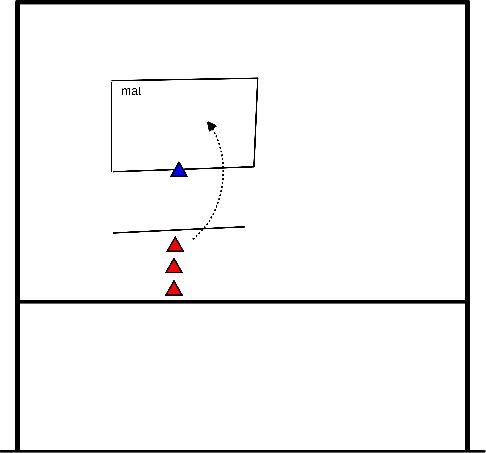Volleyball drills for technique general
- Training for upping
- At position 4 (outside attack) korfball pole with hooptied . (with sturdy velcro)
- Upper at position 2get ready. (lay down dot)
- Reserve uppers in a line on position.
- Trainer at position 5, throws the ball to upper.
- He picks up the ball through the hoop.
- Behind that, an attacker is ready to catch the ball and puts it in the trainer's ballcar.
- Catch is in the line at position 6.
- Upper is going to catch.
- Variation:
- Uppercut back to outside position.
- Throw the ball from the other side and pass to position 2.
- Have the distributor step in from position 1.
- Points of attention when upping:
- Getting under the ball, the ball should fall on your forehead.
- Hands in the shape of the ball (make sure the hands are not too far to the side; like catching an inu)
- Right foot more forward than the left.
- Face towards position 4.
- At ball contact, slightly bend the knees and push out the ball, stretching the legs.
- When playing, the ball must remain in front of the upper. (Be careful not to arch your back)
- When uppercutting backwards, bend the back along with the uppercut.
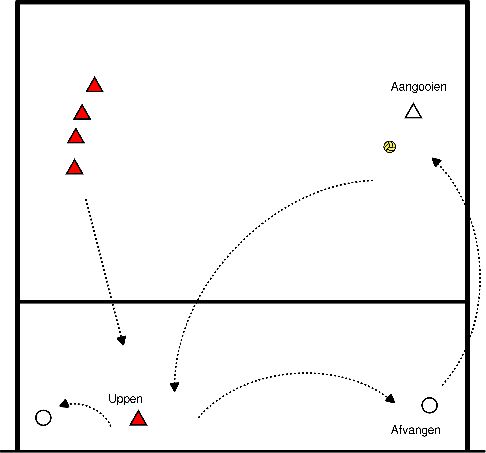
- 2 teams, whoever can move the mat the fastest across the field to the other side.
- They must all stay on the mat.
- Pass the ball overhead.
- A to C.
- C to B. (A runs to the front),
- B to D. (or A, depends on team size),
- D to A. (or C)
- The team that reaches the other side first wins.
- Objective:
- Develop ball sense, be able to control ball close to your body.
- Everyone has their own ball, can be combined with a warm-up.
- Let the ball bounce on your right fist.
- Up to maximum eye level.
- Arm is stretched out and is almost horizontal.
- Stay in one place as much as possible.
- Later on, alternate bouncing with your left hand.
- Now do the same while following the yellow lines in a certain pattern.
- The person in front chooses the route (watch out for rear-end collisions!); who wants to take this role? (requires even more concentration and a sense of responsibility a la captain's role)
- Play the ball with only your right hand above your head, up to a maximum of 30cm higher than your hand
- Your upper arm is pointed 45 degrees upwards and your forearm 45 degrees in the other direction; this brings your hand above your shoulder again.
- The ball is played mainly with your wrist and forearm; stay in one place as much as possible.
- Later on, alternate with the left hand.
- Afterwards also in pattern.
- Play the ball in a fixed routine for yourself, for example:
- Square:
- Underhand R, overhand R, overhand L, underhand L, underhand R, ...etc. (change later to the right)
- Cross:
- Lower hand R, upper hand L, upper hand R, lower hand L, lower hand R, ...etc.
- In teams of four (preferably) with each its own ball.
- Stand in a square; all equally spaced.
- Throw the ball to the next person and catch the ball that is thrown to you.
- First throw underhand and catch underhand; then throw abovehand and catch abovehand.
- Then expand by passing 1 ball.
- Choose a spot opposite the wall.
- Sit in front of the wall with your feet against the wall.
- Play overhead against the wall. (Ball just above eye level)
- Pay attention to the movement of the wrist and a little bit of the forearm.
- The ball will only bounce about 10cm this way.
- If necessary, extend the game by slowly standing up, playing standing up for 10 seconds and then sitting down again.
- Let them play a route along the wall: bounce briefly (10cm) and play overhand (right).
- At the end of the route, take a distance of 2 meter from the wall and keep on playing overhand while walking left until the beginning of the route, close to the wall.
- Everyone in line; if you lose the ball, pick it up and go back to the line.
- 3 numbers, that means that every time the teams change, since there are 11 players.
- CAUTION:
- Don't make a fuss about getting the players ready, I don't want to see the same teams every time. Everyone counts for himself.
- Trainer puts the ball in play, on the side where points are made, this can be done in different ways.
- Also, the ball is put into play at a high rate when the teams need to rotate.
- Starting with the no-go area to score points.
- The 3-yard line.
- So hopefully they are smart enough not to defend in the 3 meter area.
- Free play, full out, have it all.
First phase, per 2:
- Pitcher has 2 tennis balls,
- Which he takes turns throwing into a zone where the receiver is standing,
- Short distance
- Receiver catches with 1 hand each time
- Same with volleyballs
- Receiver doesn't catch anymore, but plays back underhand.
- Receiver doesn't catch anymore, but plays back underhand.
Place 1 or 2 ladders in a row, to create an exercise on length.
Perform a number of variations, starting with easy exercises and slowly working your way up to more difficult ones. Continuously ending with a 10 meter sprint
- Start simple, with 2 feet continuously in the ladder.
- Short quick movements
- Next,
- 1 foot outside ladder,
- 2 feet inside ladder,
- 1 foot outside the ladder.
- hopscotch,
- 1st box: only left foot.
- 2nd compartment: both feet.
- 3rd box: right foot.
- etc
- jump off your left foot, onto the left side of the ladder.
- --> to the other side of the ladder, landing on your right foot (one square further).
- Jump to the end in a slalom fashion.
- Stand horizontally with your hands in the ladder.
- And go sideways through the ladder, hands together continuously in one compartment.
- Do it again, but with a push-up between the different squares.
- Lateral knee lifts through the ladder
- Place a pawn/stack of hats in every odd ladder square, which must be jumped over.
- Continuous jumping, using both feet (arms in the air)
- Leg swing 20x forward left and right
- Leg swing 20x sideways left and right
- Lunge with twist: Big step forward, good to the ground, and rotate trunk to left and right 20x
- Plank: 30 sec
- Side plank: both 30 sec
- 15 sit-ups both sides
- 15 push-ups
- 10 burpees
- Stomp, slowly build up to 100% and loose to sprint
Form pairs,
- Each pair has 2 tennis balls and holds the tennis balls with outstretched arms
- The other player stands opposite, with his hands above the hands of the person with the tennis ball
- The person with the tennis ball drops one of the tennis balls, while the other person tries to catch it before it hits the ground.
- Often the volleyball field is divided into six positions, you can also divide the field into nine sections of three by three meters.
- This can be of value in coaching, service and (tactical) attack.
- I let the group hold hands and then call a number below ten.
- The group must then move as quickly as possible to the appropriate section.
- Tip: After practicing this, I call out a number under ten at practice and have players point to the appropriate section on the court.
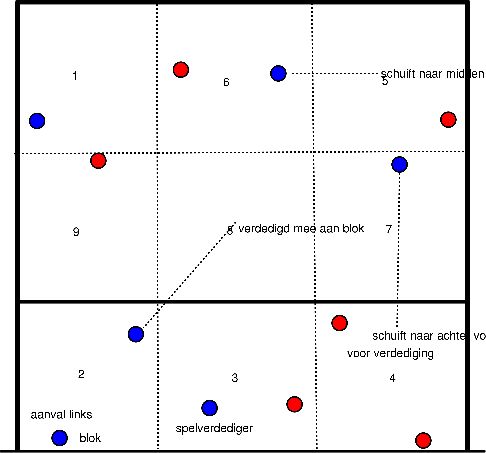
Arrangement of equipment:
- The trainer stands with a large ball ready in his hands.
- The players all hold a regular volleyball.
Course of play:
- The players throw their ball to the trainer.
- The trainer lets the ball bounce on his big air ball.
- The ball will bounce to different sides, the children try to catch the ball.
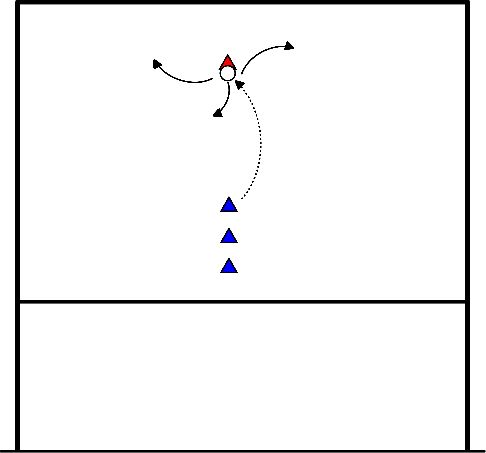
set up of equipment:
- Goal in the middle of the field, with someone in it
- Other players on the other side of the net.
Course of play:
- The players throw/strike the ball towards the goal and try to score in the goal.
- The player in the goal (blue) tries to keep the balls out of the goal.
Remark:
Set the net as low as possible.
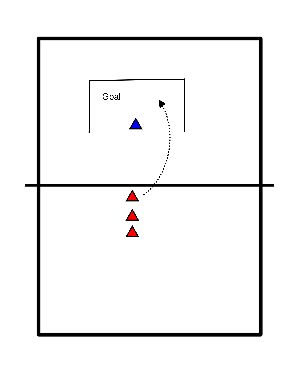
Arrangement of material:
- Mat against a wall
- Player 1 (blue) near the mat
- Other players (red), behind a certain line (depends on players)
Game flow:
- The players behind the line throw the ball to the mat
- Player 1 tries to keep the ball from the mat, he can do this with various movements.
As soon as one of the players touches the mat, they may take a marker from Player 1.
If Player 1 has no more marker disc, he loses and another player may take it. (number to choose, for example 5)
